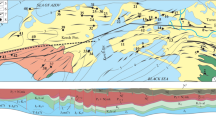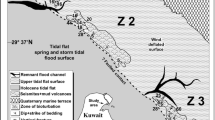Abstract
The South Caspian sedimentary basin is a unique area with thick Mesozoic-Cenozoic sediments (up to 30–32 km) characterized by an extremely high fluid generation potential. The large amount of active mud volcanoes and the volumes of their gas emissions prove the vast scale of fluid generation. Onshore and offshore mud volcanoes annually erupt more than 109 cubic meters of gases consisting of CH4 (79–98%), and a small admixture of C2H6, C3H8, C4H10, C5H12, CO2, N, H2S, Ar, He. Mud volcanism is closely connected to the processes occurring in the South Caspian depression, its seismicity, fluctuations of the Caspian Sea level, solar activity and hydrocarbon generation.
The large accumulations of gas hydrates are confined to the bottom sediments of the Caspian Sea, mud volcanoes crater fields (interval 0–0.4 m, sea depth 480 m) and to the volcanoes body at the depth of 480–800 from the sea bottom. Resources of HC gases in hydrates saturated sediments up to a depth of 100 m and are estimated at 0.2×1015–8×1015 m3. The amount of HC gases concentrated in them is 1011–1012 m3.
The Caspian Sea, being an inland closed basin is very sensitive to climatic and tectonic events expressed in sea level fluctuations. During regressive stages as a result of sea level fall and the reducing of hydrostatic pressure the decomposition of gas hydrates and the releasing of a great volume of HC gases consisting mainly of methane are observed.
From the data of deep drilling, seismoacoustics, and deep seismic mud volcanic activity in the South Caspian Basin started in the Lower Miocene. Activity reached its highest intensity at the boundary between the Miocene and Pliocene and was associated with dramatic Caspian Sea level fall in the Lower Pliocene of up to 600 m, which led to the isolation of the PaleoCaspian from the Eastern ParaTethys. Catastrophic reduction of PaleoCaspian size combined with the increasing scale of mud volcanic activity caused the oversaturation and intoxication of water by methane and led to the mass extinction of mollusks, fishes and other groups of sea inhabitants. In the Upper Pliocene and Quaternary mud volcanism occurred under the conditions of a semi-closed sea periodically connected with the Pontian and Mediterranean Basins. Those stages of Caspian Sea history are characterized by the revival of the Caspian organic world.
Monitoring of mud volcanoes onshore of the South Caspian demonstrated that any eruption is predicted by seismic activation in the region (South-Eastern Caucasus) and intensive fluid dynamics on the volcanoes.







Similar content being viewed by others
References
Aliyev ChS, Feyzullayev AA, Zolotovitskaya TA (2001) Peculiarities of radioactive fields of mud volcanoes of Azerbaijan. Geophysics News in Azerbaijan 3:25–32
Aliyev AA, Guliyev IS, Belov IS (2002) Catalogue of recorded eruptions of mud volcanoes in Azerbaijan (for period of years 1810–2001). Nafta Press, Baku, 87 pp
Etiope G, Klusman RW (2002) Geologic emissions of methane to the atmosphere. Chemosphere 49:777–789
Faber EZ (1987) Isotopengeochemie gasformiger Kohlenwasserstoffe. Erdole Erdgas Kohle 103:210–218 (in German)
Feyzullayev AA, Huseynov DA (2002) Peculiarities of oil-gas formation within Baku archipelago. Azerbaijan Oil Industry, Baku, N4, pp 1–5
Gorin VA, Buniatzadeh ZA (1971) Deep faults, gas-oil volcanism and oil-gas pools of the western flank of South Caspian depression. Azerbaijan State Publishing House, Baku, 190 pp
Guliyev IS, Aliyeva EH, Huseynov DA (2001) Deep sources of hydrocarbon formation in the South Caspian basin. Proceedings of Geology Institute, Baku, No 29, pp 79–99
Guliyev IS, Feyzullayev AA, Huseynov DA (2001a) Isotope geochemistry of oils from fields and mud volcanoes in the South Caspian Basin, Azerbaijan. Petroleum Geoscience 7(2):201–209
Guliyev IS, Feyzullayev AA, Huseynov DA (2001b) Isotopic composition of carbon of the hydrocarbon fluids in the South Caspian megadepression. Geochemistry, Moscow 3:271–278 (in Russian)
Guliyev IS, Huseynov DA, Aliyeva EG (2001) Mud volcanoes in the South Caspian basin-deep sources and dynamics of development. In: Natural Hydrocarbon Seeps, Global Tectonics and Green House Gas Emission. Delft, The Netherlands, pp 23–27
Guliyev IS, Kadirov FA, Reilinger RE, Gasanov RI, Mamedov AR (2002) Active tectonics in Azerbaijan based on geodetic, gravimetric and seismic data. Transactions (Doklady) of the Russian Academy of Sciences/Earth Science Section 383(2):174–177
Guliyev IS, Mamedov PZ, Feyzullayev AA, Huseynov DA, Kadirov FA, Aliyeva EH, Tagiyev MF (2003) Hydrocarbon systems of the South Caspian basin. Nafta-Press, Baku, 206 pp
Huseynov DA (2000) Origin of oils in the western part of the Kura-South Caspian oil-gas bearing basin. In: Extended Abstracts Book, 62th EAGE Conference and Technical Exhibition, Glasgow, UK, pp A-55
Huseynov DA, Guliyev IS, Feyzullayev AA (2000) Isotope-geochemical prognosis of the stratigraphic origin of the oil seepage sources in the South Caspian. In: Abstract book of AAPG’s Inaugural Regional International Conference “Oil and Gas Business of the Greater Caspian Area-Present and Future Exploration and Production Operations”, July 9–12, Istanbul, Turkey, pp 28–30
Huseynov DA, Guliyev IS, Feyzullayev AA (2003) Geochemical features and sources of fluids of mud volcanoes of the South Caspian basin according of carbon, hydrogen and oxygen new isotopic data. Accepted to publication in J. Geochemistry in No 6 of 2004, Moscow
Javadova R, Muradov Ch, Feyzullayev A (2001) About Nature and stratum occurrences of gas-hydrates hydrocarbon gases in the Caspian Sea. In: Abstract book of EAGE 63th Conference and Exhibition, Amsterdam, The Netherlands,11–15 June, 561 pp
Judd AG, Hovland M, Dimitrov LI, Garcia G, Jukes V (2002) The geological methane budget at continental margins and its influence on climate changes. Geofluids 2:109–126
Katunin D, Golubov B, Kashin D (2002) Hydrovolcanism and degassing of earth bowel as the possible reason of scale death of sprats on the Middle Caspian Sea during 2001 spring. In: Abstract book of 7th International Conference “Gas in Marine Sediments”, October 7–12. Nafta-Press, Baku, 93 pp
Knapp JH, Diaconescu CC, Conner JA (2000) Deep seismic exploration of the South Caspian Basin: Lithosphere-scale imaging of the World’s deepest basin. In: Abstract book of AAPG’s Inaugural Regional International Conference “Oil and Gas Business of the Greater Caspian Area-Present and Future Exploration and Production Operations”, July 9–12, Istanbul, Turkey, pp 35–37
Lilienberg DA (1999) Morphostructure and tectonic-climatic mechanism of the Caspian Sea level fluctuation. In: Recent tectonic and its impact on formation and location of oil-gas pools. Nafta Press, Baku, pp 112–124
Mamedov PZ (1991) Seismostratigraphic studies of the geologic structure of the South Caspian megabasin in connection with the prospects of petroleum presence. Doctoral dissertation, Geology Institute, Baku, 491 pp
Mekhtiev ShF, Khalilov EN (1988) How the Earth develops. Znanie, Baku, 23 pp
Milkov AV, Sassen R, Apanasovich T, Dadashev FG (2003) Global gas flux from mud volcanoes: A significant source of fossil methane in the atmosphere and the ocean. Geoph Res Lett 30(2):9.1–9.4
Muradov ChS (2002) Estimation of resources of gas in gas hydrate accumulations of Southern Caspian Sea. In: Abstract book of 7th International Conference “Gas in Marine Sediments”, October 7–12. Nafta-Press, Baku, pp 149–150
Reynolds AD, Simmons MD, Bowman MB, Henton J, Brayshaw AC, Ali-Zade AA, Guliev IS, Suleymanova SF, Ataeva EZ, Mamedova DN, Koshkarly RO (1998) Implications of outcrop geology for reservoirs in the Neogene Productive Series: Absheron Peninsula. AAPG Bulletin 82:25–49
Vinogradov AP, Keller BM, Predtechenskiy NN, Nalivkin VD, Pozner VM (1968) Atlas of lithology-paleogeographical maps of the south of USSR, Vol. 4. GUGK, Moscow
Zonenshine LP, Kuzmin MI, Natanov LM (1990) Tectonics of the lithosphere plates of the USSR territory, Book 2. Nedra, Moscow, 400 pp
Yagubov AA, Alizade AA, Zeynalov MM (1971) Atlas of mud volcanoes of Azerbaijan. Baku, Publishing house of the Academy of the Sciences, 258 pp
Acknowledgement
The authors are very grateful to P.Z. Mamedov (Azerbaijan State Oil Academy), A.A. Feyzullaev, A.A. Aliyev and Ch.S. Muradov (Geology Institute, Baku), B. Garrison (Ocean Sciences Department, University of California, USA), A. Judd (Applied Geology, University of Sunderland, UK), S. Kroonenberg and F. van Meer (Delft University, The Netherlands), K. Kvenvolden (Geological Survey of USA), G. Etiope (Instituto Nazionale di Geofisica e Vulcanologia, Rome, Italy) for fruitful discussion. The authors thank the staff of NASA for supporting this research on monitoring submarine volcanoes in the Caspian Sea. The authors also thank reviewers C. Baciu and F. Italiano for precise and helpful comments of this work.
Author information
Authors and Affiliations
Corresponding author
Rights and permissions
About this article
Cite this article
Huseynov, D.A., Guliyev, I.S. Mud volcanic natural phenomena in the South Caspian Basin: geology, fluid dynamics and environmental impact. Env Geol 46, 1012–1023 (2004). https://doi.org/10.1007/s00254-004-1088-y
Received:
Accepted:
Published:
Issue Date:
DOI: https://doi.org/10.1007/s00254-004-1088-y




